Method and apparatus for making a nonwoven from crimped filaments
a technology of crimped filaments and nonwoven webs, which is applied in the field of apparatus for making a nonwoven web from crimped filaments, can solve the problems of disturbing the defect site or filament clumping in the nonwoven web or in the nonwoven web surface, and reducing the thickness and/or the softness of nonwovens. , to achieve the effect of optimal surface properties, great thickness and optimal properties
- Summary
- Abstract
- Description
- Claims
- Application Information
AI Technical Summary
Benefits of technology
Problems solved by technology
Method used
Image
Examples
Embodiment Construction
[0053]FIG. 1 shows an apparatus according to the invention for making a spunbonded nonwoven web 1 from continuous filaments 2 of thermoplastic resin. The apparatus has a spinneret 10 for spinning the continuous filaments 2 that then pass. downward through a cooler 11 having a cooling chamber 12. Preferably and in the embodiment according to FIG. 1, two vertically stacked air-supply manifolds 13 and 14 laterally flank the cooling chamber 12. Air of different temperatures is expediently introduced into the cooling chamber 12 from these air-supply manifolds 13 and 14. As recommended and in the embodiment, a monomer extractor 15 is provided between the spinneret 10 and the cooler 11. This monomer extractor 15 draws toxic gases made during the spinning process from the apparatus. These gases are, for example, monomers, oligomers, or decomposition products and the like.
[0054]The cooler 11 is preferably and in this embodiment followed in the filament flow direction by a downstream stretche...
PUM
| Property | Measurement | Unit |
|---|---|---|
| lengths | aaaaa | aaaaa |
| angle | aaaaa | aaaaa |
| length | aaaaa | aaaaa |
Abstract
Description
Claims
Application Information
 Login to View More
Login to View More - R&D
- Intellectual Property
- Life Sciences
- Materials
- Tech Scout
- Unparalleled Data Quality
- Higher Quality Content
- 60% Fewer Hallucinations
Browse by: Latest US Patents, China's latest patents, Technical Efficacy Thesaurus, Application Domain, Technology Topic, Popular Technical Reports.
© 2025 PatSnap. All rights reserved.Legal|Privacy policy|Modern Slavery Act Transparency Statement|Sitemap|About US| Contact US: help@patsnap.com


